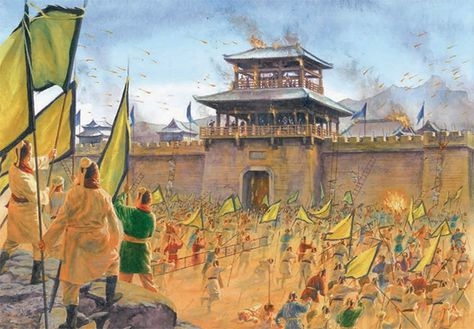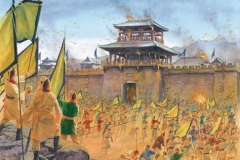The Yellow Scarves Rebellion (184 AD) is the introductory event to the epic of the Romance of the Three Kingdoms and the first of a long line of events signifying to the reader that both nobles and common people recognized the Han dynasty was nearing its end.
In Chinese, the name “Yellow Scarves” is Huang Jin. Yellow is the imperial color; the word Jin, “a piece of cloth,” is the lower element in the graph Di, “emperor.” Rebels often established a counter-emperor to challenge the one in power. The Yellow Emperor, Huangdi, was the patron saint of medicine and is perhaps illustrative of the comment Zhange Jue “gathering medical herbs.” In Five Agents theory, yellow represents earth which overcomes fire. The Usurper Wang Mang adopted yellow as his symbolic color, so did the house of Wei after accepting the abdication of the Han. The yellow band around the head or hair—sometimes translated as “turban,” as with the Yellow Rebellion Rebellion—of the rebels suggests the forbidden “yellow at the top,” i.e. “one who imitated the emperor’s yellow carriage top and flags… acted unlawfully” (T’ung-tsu 1972, p. 68).
The Yellow Scarves were critical in setting up how the major characters see the Han Imperial government prior to the tyrants and warlords period that immediately followed the suppression of the rebellion. For example, Guan Yu’s anti-government actions prior to joining up with Liu Bei and Zhang Fei showed he was not necessarily a fan of the Han government, and he likely participated in proto-populists upraising activities in the murdering of the corrupt government official. This extra layer of depth could not be added later to the plot, as the main heroes’ agendas throughout the story are focused on fighting each other and using the Emperor as a pawn in their Great Game.
Oftentimes, the Han was considered as an after-thought in the main characters’ machinations, even by such heroes as Liu Bei who generally was considered to want to preserve the Han. Ma Teng is another main character that was shown to be acting on behalf of the Han, but his Xiliang forces were similar to those that Dong Zhou and later Li Jue and Guo Si used to burn down the capital Luoyang and hold the Imperial government hostage for several years. If characters such as Ma Teng seized the role of “protector” of the Han, the narrative would have continued on course without much change.
Other than a foil to the characters’ personalities and to introduce them to the plot, the Yellow Scarves Rebellion plays little part in the rest of the epic. Embers pop up now and again throughout the story, but mostly as a convenient target for the main characters to win easy victories against uppity peasant farmers and belittle the common worries of the main population. Its main purpose was to serve as a manifestation and boogieman of the people’s dissatisfaction with whatever government they were made to suffer under and was non-responsive to their plight.
Sources
T’ung-tsu Ch’u (1972). Han Social Structure. University of Washington Press.



